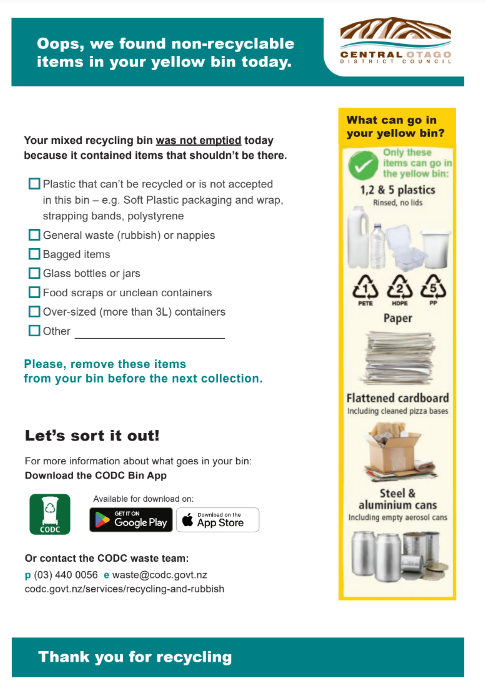Standardised kerbside collection kicks in
Alexia Anderson
01 February 2024, 4:15 PM
 Standardised kerbside collection will be rolled out across the country from today. PHOTO: File
Standardised kerbside collection will be rolled out across the country from today. PHOTO: FileCentral Otago District Council (CODC) is ahead of the game, as the nation moves to standardise what materials go in kerbside bins.
From today, territorial authorities will be required to standardise the system, ensuring the same rules apply throughout the country.
Central Otago’s kerbside collection was altered in July, last year, with the introduction of the food scraps and greenwaste (organics) collection, which has given residents a chance to get used to the new system before it became mandatory.
CODC infrastructure manager Quinton Penniall said while many Central residents were on board with the new system, a six-month report card would read: “Overall good effort, could do better”.
“Generally, our team’s bin audits have shown a shift in people’s waste behaviour as they adapt to the new four-bin configuration. The community’s response to the green bin shows a commendable understanding of what should and shouldn’t go into the bin.”
However, the same cannot be said for the yellow bins.
“Our team and the truck drivers have noticed a genuine effort in recycling correctly, but many are still placing non-recyclable items in these bins. The most frequent non-recyclable item is soft plastic, found in 65 per cent of the audited bins containing incorrect items.”
Soft plastic encompasses various “scrunchable” plastic packaging, ranging from chip packets and bread bags to dog food sacks and films on meat trays.

The letter that residents receive if their yellow bin is contaminated. IMAGE: CODC
Those items can only be recycled at Soft Plastic Recycling drop-off bins at New World, Countdown and The Warehouse in Alexandra.
A CODC waste team spokesperson said some obvious signs truck drivers watch out for, which can suggest a yellow bin contains the wrong items, are overfilled bins, or bins with rubbish sacks spilling out the top.
A variety of cameras in the trucks allow the drivers to see what is emptied into the hopper.
A computer and GPS allows the drivers to tag a location where they spot the incorrect items in a bin.
The property will be flagged the following week and the driver is prompted to check the bin before emptying it.
If a driver finds a contaminated bin they leave a letter in the resident’s letterbox or under the handle of the bin explaining what has happened and why.
The blue bin has also been problematic in recent times, with some people treating it like a “party bin”.
“It is really great to see people trying to collect up all their glass bottles for recycling after a gathering, but the cardboard boxes and sleeves and aluminium cans need to go in the yellow bin. The lemon wedges need to go in the green bin and the chip packets in the red bin - or saved to take to a soft plastics recycling drop off point.”
The Government’s new standards will not bring significant changes to the Central Otago kerbside service.
The most noticeable change is that animal droppings, fur and hair will no longer be accepted in the green bin.
Listen to The Outlet podcast where Lauren Hunter talks more about the standardised kerbside collection.
Learn more by reading 'Your guide to Central Otago's new kerbside collection'.







